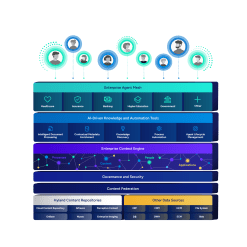Virginia Community College System
Modern content services digitize, automate and expedite key workflows for faculty and students

Harness the power of a unified content, process and application intelligence platform to unlock the value of enterprise content.
Learn more
Automate your document-centric processes with AI-powered document capture, separation, classification, extraction and enrichment.
Learn about Hyland IDPIt's your unique digital evolution … but you don't have to face it alone. We understand the landscape of your industry and the unique needs of the people you serve.
 Overview of industries
Overview of industries
Countless teams and departments have transformed the way they work in accounting, HR, legal and more with Hyland solutions.
 Overview of departments
Overview of departments
We are committed to helping you maximize your technology investment so you can best serve your customers.
 Overview of services
Overview of services

Discover why Hyland is trusted by thousands of organizations worldwide.
Hear from our customers
Our exclusive partner programs combine our strengths with yours to create better experiences through content services.
Overview of partners
Join The Shift newsletter for the latest strategies and expert tips from industry leaders. Discover actionable steps to stay innovative.
Register now
Hyland connects your content and systems so you can forge stronger connections with the people who matter most.
Learn about HylandWith our modern, open and cloud-native platforms, you can build strong connections and keep evolving.
 Dig deeper
Dig deeper
Reading time minutes
Modern content services digitize, automate and expedite key workflows for faculty and students

Every year, approximately 212,000 students continue their education across the Virginia Community College System (VCCS), which comprises a network of 25 agencies (23 community colleges, a system office and a shared service center) across 40 campuses. VCCS’ large footprint and student population have historically meant that paperwork was challenging and burdensome for staff.
Nearly half of VCCS’ colleges moonlighted as document input, output and retention centers. Michelle Johnson, a software applications specialist at VCCS, said at one point, “eight of the colleges served as the front office; a ninth college was the back office and performed processing for verification, loans and other financial processes; and a 10th college then signed on to be the filing cabinet.”
VCCS sought a way for its colleges to scan and digitize paperwork to streamline processes and expedite answers, which is especially important in institution-critical departments like accounts payable/receivable, human resources and enrollment management.
In 2012, VCCS deployed Hyland’s Perceptive Content, a content and process management suite. VCCS implemented the solution not only to scan and save documents but also to automate processes while securely managing the entire content life cycle. After years of success with that Hyland solution, one of the VCCS colleges, Northern Virginia Community College, purchased Brainware for Transcripts. A second college, Tidewater Community College, followed suit in 2022. In 2023, Brainware integrated with the VCCS ERP Oracle Campus Solutions 9.2. The two colleges are in their rollout phase for this integration. This robust system eliminates the need to manually sort and key data from even the most complex, diverse document types, accurately capturing student and course data regardless of layout.
Johnson said VCCS leans on Hyland software to streamline and expedite its extensive workflows.
“We use the import agent, the mail agent, Brainware for Transcripts, the user replication agent, content apps, content explorer, search, install client, internal e-forms and business insight. I’m pretty sure there’s more,” she said.
One critical component of successful deployment and user adoption was the institution’s focus on change management, said Nicole Stewart, Assistant Vice-Chancellor of IT services at VCCS.
“You can’t just take that IT request and turn it into a configuration and hand it back over the wall and say, ‘OK, I did what your request said,’ because that’s not the end of the story. Bringing the consumer to the table is really important,” she said.
Before VCCS implemented Hyland solutions, the number of digital documents leveraged across campus “was almost zero,” said Emilio Acevedo, manager of access and content applications at VCCS. In 2022, the institution added nearly 650,000 documents to Perceptive Content. As of January 2023, more than 8.5 million documents are presently managed in the system.
Additionally, with the help of Brainware for Transcripts, VCCS can process up to 125,000 transcripts a year, which saves considerable printing costs and frees up valuable office space.
The Hyland solutions helped VCCS staff by freeing them up for higher-value, more engaging work. They also empowered students to access and update information from any location in real time. Both of these features are essential to meeting the expectations of 21st-century staff and students.
Johnson said that the Hyland solutions allowed VCCS employees to have better efficiencies with processing documentation. Before, she added, “There was always that risk of losing an important piece of paper.” Now, however, “they’re not losing paper or shuffling paper around,” but instead are closing the loop in departmental workflows in a timely manner and with fewer errors.
As Hyland software continues to generate measurable value across VCCS, the next steps are further expansion. Departments are hearing about the benefits via word of mouth from someone in another department, “or somebody in IT will overhear a conversation and say, ‘Hey, we’ve got the perfect solution for you,’” Johnson said. Their plan includes moving all users to the web client, demoing the software to the rest of the user groups as well as considering implementing Brainware for Invoices at its shared services center.
“We, of course, want to expand the use of Hyland solutions to more departments as well as enhance the workflows that are already in use — and create some that are not,” she added.